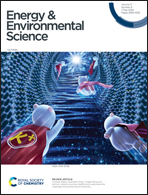Integrated carbon capture and CO production from bicarbonates through bipolar membrane electrolysis†
Abstract
The electrochemical CO2 reduction reaction (CO2RR) offers an environmentally friendly method to transform sequestered CO2. While gas-phase electrolysis systems provide high efficiency, gas-phase electrolysis systems face challenges related to carbonate precipitate formation and crossover. As an alternative, liquid-phase (bi)carbonate electrolysis systems based on the use of bipolar membrane (BPM) electrode assemblies have emerged. These systems not only streamline the carbon capture and conversion process but also present economic benefits. However, liquid-phase (bi)carbonate electrolysis cells suffer limited stability and selectivity at relevant operating currents. Here, utilizing a Ni-based single atom catalyst (Ni-SAC) and bicarbonate electrolyte, we demonstrate exceptional CO faradaic efficiency (93%) at a partial current density of −186 mA cm−2 at −3.7 V for over 18 hours with an integrated carbon capture system. Furthermore, we conducted a comparative analysis of various performance metrics between bicarbonate electrolysis and CO2 gas electrolysis. Our results highlight the superior advantages of BPM-based electrolysis in terms of CO2 utilization efficiency, stability, and CO product concentration in the outlet stream. Despite a higher energy demand, BPM-based electrolysis presents a technologically promising alternative to conventional CO2 gas-phase systems. This breakthrough paves the way for efficient direct carbon capture and conversion, offering a promising pathway toward a more sustainable and carbon-neutral future.



 Please wait while we load your content...
Please wait while we load your content...